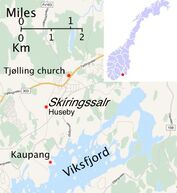
Fortunately for me, Kaupang has a wealth of preserved material culture, including a number of textiles. The famous grave of the "Oseberg Queen" is also not far away chronologically (834 CE) or geographically (it is within the same modern day county). The grave provides information on shoes and textiles, as well as other material culture, and the settlement and graves give me additional textiles and a wealth of jewelry and beads to work from. In reality, I did not have to stray too far to build out plans for moving forward.
Were I looking for additional details, trade routes come into heavy play, and I could easily tap into Denmark (assuming I stick to 9th century), but I would most definitely avoid something like finds specific 10th Century Birka unless I had no other option for evidence.
And entire extant garments? We just don't them for this time+place+culture. This begins a delicate game of research where you have to start building a puzzle with pieces that definitely do not belong together, but if you manage to chose the right ones, you can still form a plausible picture in the end.
An example is the Iron Age textiles from Vedretta di Ries in Italy. There are shaped leggings as well as shoe linings. These could be a basis for leg coverings, though they potentially date early for my La Tene A kit (socks date 795-466BCE; La Tene A is 450-380BCE). They are from Italy but not horribly far from Hallein. There are socks from Martres de Veyre in France, but these date late 2nd-early 3rd century CE, and are much, much further from Hallein. Additionally, they are completely separated from my chosen location by the Alps. If I were to have only these options to work from, the Italian find is much better fit for my puzzle. (Of course, I could also analyze both and draw comparisons between the two - and any other relevant leg coverings I could track down - and possibly even make a case for similarities and possible use across a more broad span of time, if I felt like trying to go down that particular path.) It not always easy to juggle the priority of time, place, and culture to make the best guesses we can.
I also enjoy all of this as a bit of experimental archaeology as well. If I have several possible items, I might make them and test them out. Do they work in reality? Are they functional? Do they serve a purpose or in some way pull other things together? It is fascinating what you can learn by wearing and doing.
In the end though, we sometimes we have to use what we have until something better is found. We go early or late, and skip across modern borders, to build out the best look that we can, while realizing all the while that it is the best we can do now, and the process is never truly done and we will always find more pieces to our puzzle.
 RSS Feed
RSS Feed